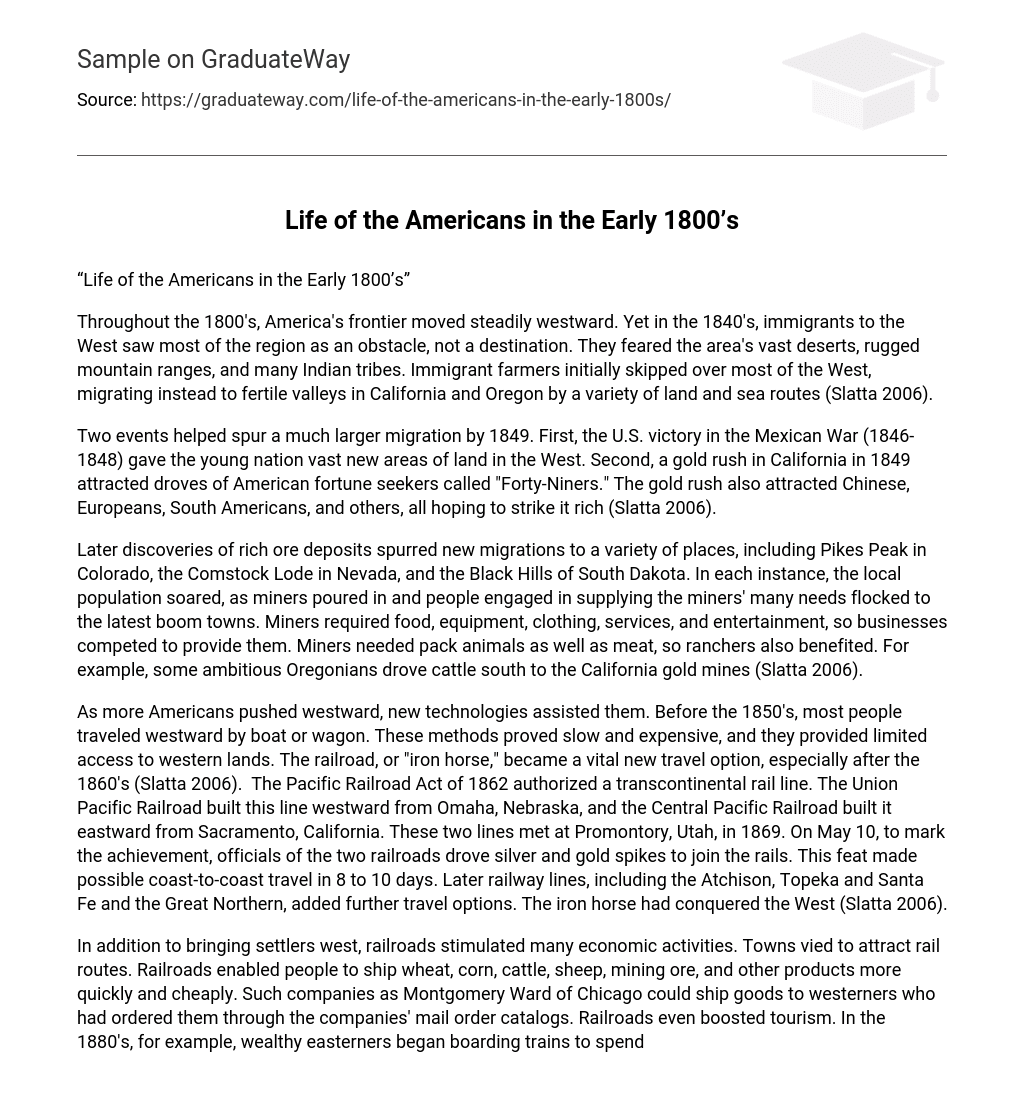“Life of the Americans in the Early 1800’s”
Throughout the 1800’s, America’s frontier moved steadily westward. Yet in the 1840’s, immigrants to the West saw most of the region as an obstacle, not a destination. They feared the area’s vast deserts, rugged mountain ranges, and many Indian tribes. Immigrant farmers initially skipped over most of the West, migrating instead to fertile valleys in California and Oregon by a variety of land and sea routes (Slatta 2006).
Two events helped spur a much larger migration by 1849. First, the U.S. victory in the Mexican War (1846-1848) gave the young nation vast new areas of land in the West. Second, a gold rush in California in 1849 attracted droves of American fortune seekers called “Forty-Niners.” The gold rush also attracted Chinese, Europeans, South Americans, and others, all hoping to strike it rich (Slatta 2006).
Later discoveries of rich ore deposits spurred new migrations to a variety of places, including Pikes Peak in Colorado, the Comstock Lode in Nevada, and the Black Hills of South Dakota. In each instance, the local population soared, as miners poured in and people engaged in supplying the miners’ many needs flocked to the latest boom towns. Miners required food, equipment, clothing, services, and entertainment, so businesses competed to provide them. Miners needed pack animals as well as meat, so ranchers also benefited. For example, some ambitious Oregonians drove cattle south to the California gold mines (Slatta 2006).
As more Americans pushed westward, new technologies assisted them. Before the 1850’s, most people traveled westward by boat or wagon. These methods proved slow and expensive, and they provided limited access to western lands. The railroad, or “iron horse,” became a vital new travel option, especially after the 1860’s (Slatta 2006). The Pacific Railroad Act of 1862 authorized a transcontinental rail line. The Union Pacific Railroad built this line westward from Omaha, Nebraska, and the Central Pacific Railroad built it eastward from Sacramento, California. These two lines met at Promontory, Utah, in 1869. On May 10, to mark the achievement, officials of the two railroads drove silver and gold spikes to join the rails. This feat made possible coast-to-coast travel in 8 to 10 days. Later railway lines, including the Atchison, Topeka and Santa Fe and the Great Northern, added further travel options. The iron horse had conquered the West (Slatta 2006).
In addition to bringing settlers west, railroads stimulated many economic activities. Towns vied to attract rail routes. Railroads enabled people to ship wheat, corn, cattle, sheep, mining ore, and other products more quickly and cheaply. Such companies as Montgomery Ward of Chicago could ship goods to westerners who had ordered them through the companies’ mail order catalogs. Railroads even boosted tourism. In the 1880’s, for example, wealthy easterners began boarding trains to spend time on dude ranches, which provided them a brief taste of western ranch life (Slatta 2006). New forms of communication also transformed the West. During the early days of the frontier, a letter took months to travel from the Midwest to California. But several developments soon made communication much faster. In April 1860, a mail service called the pony express began carrying mail between St. Joseph, Missouri, and Sacramento. The service’s horseback riders usually made their long journey in about 10 days (see Pony express). The telegraph soon ended the need for the pony express. This instrument, the first used to send messages by means of wires and electric current, could transmit messages in minutes. Transcontinental telegraph service was established in 1861 (Slatta 2006).
Some people thought that life in the West was filled with adventure. Young men were drawn to the cowboy life. Few of the freed slaves could afford to own land and most worked as sharecroppers, work not very different from what they did as slaves. Thousands of black families took advantage of the opportunity to become homesteaders on the Plains. Children often entered the work force at age eight or nine because parents needed their children’s wages. They worked in coal mines, textile mills and other factories. Without safety regulations, children were three times more likely to hurt themselves than adults. 10-hour workdays were common and wages were barely enough to live on. Workers had no health coverage or other benefits. No regulations on safety. Frequent accidents occurred in factories, especially involving children who might fall asleep or be less attentive. A tragic fire at the Triangle Shirtwaist factory in N.Y. killed 141 seamstresses who were unable to escape because exits were locked. Educated Women could not participate in the elections. In large cities, women campaigned hard for suffrage, and gradually more and more states allowed women to vote. The important role played by women workers in World War II tipped the balance in favor of granting women suffrage (USII 2008).
Today, the women can now participate and vote in the elections. Black Americans, though still affected by what happened during the early 1800’s, slowly healing of their past. Children were given rights to have education. Policies were created for the safety of the workers. And benefits were now given to them.
Reference:
Slatta, Richard W. Slatta, Richard W. “Western frontier life in America.” World Book Online Reference Center. 2006. World Book, Inc. 19 Jan. 2006 <http://www.worldbookonline.com/wb/Article?id=ar599110>.
“USII.3a-f Study Guide Life Changes After the Civil War”. C.2008. <http://www.solpass.org/7ss/standards/StudyUSII.3.htm>.





